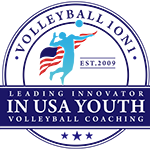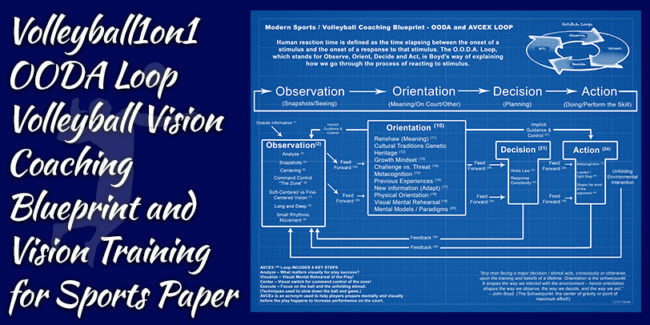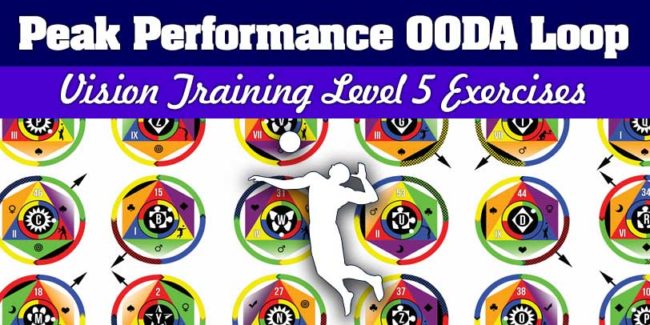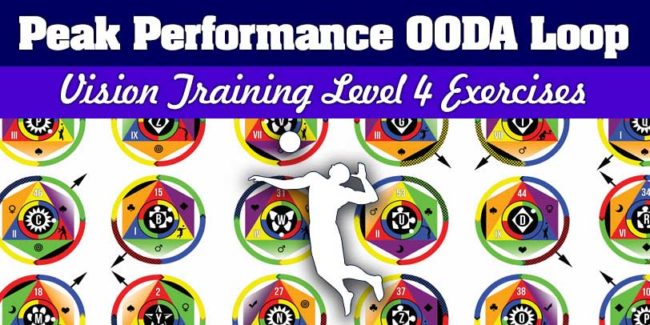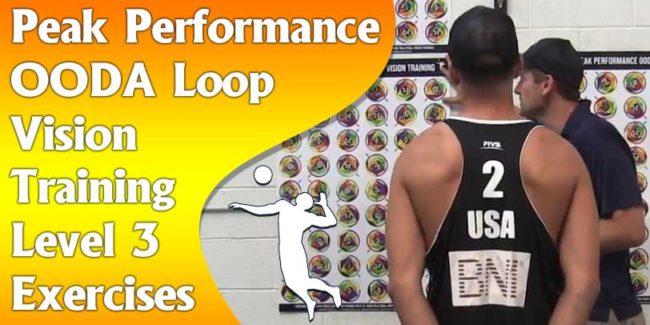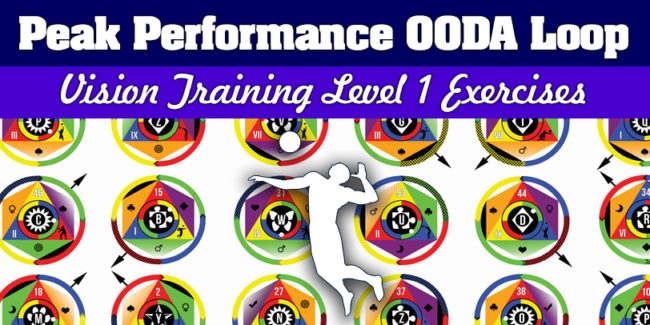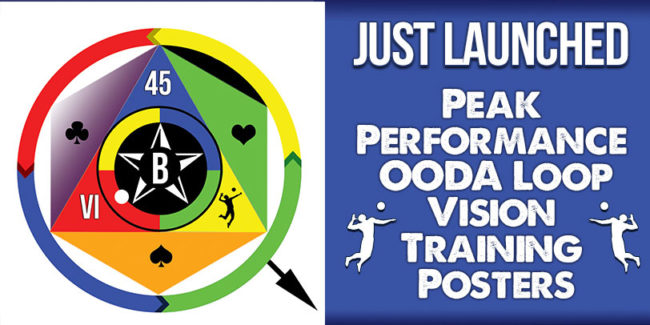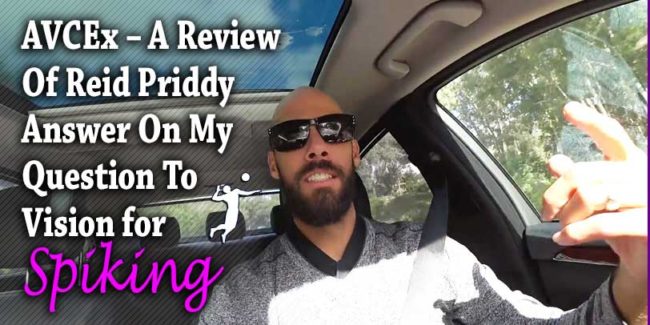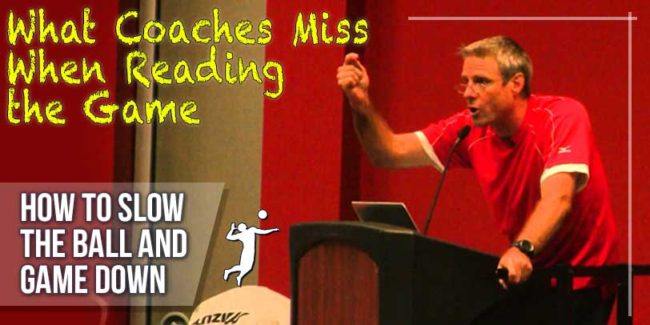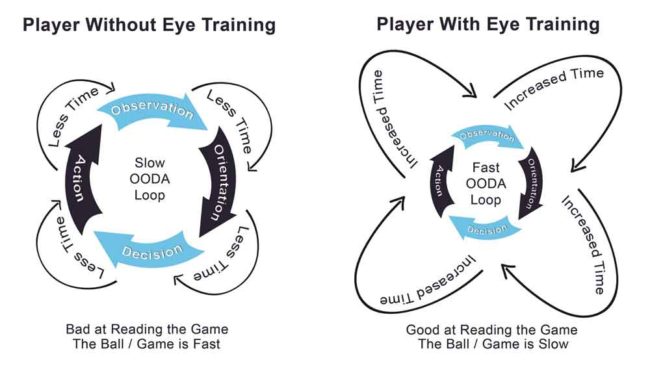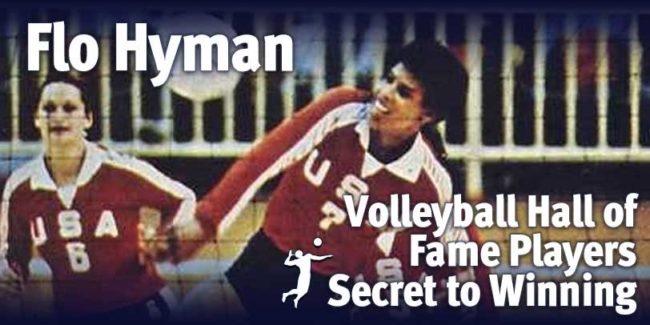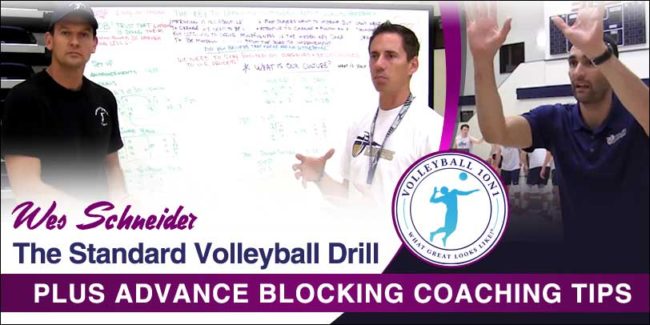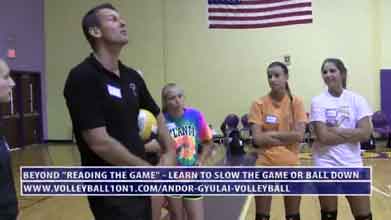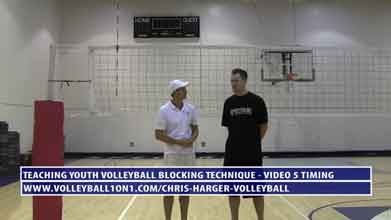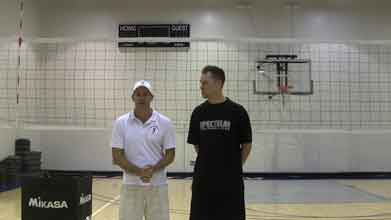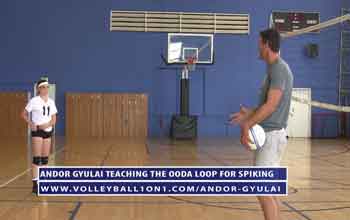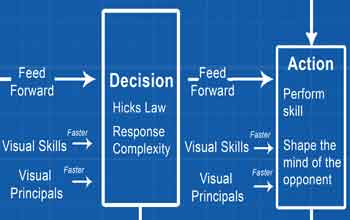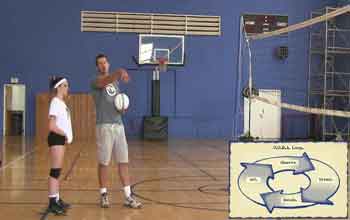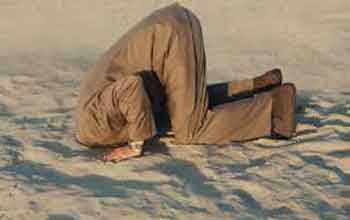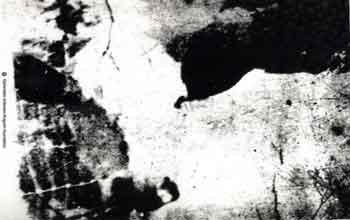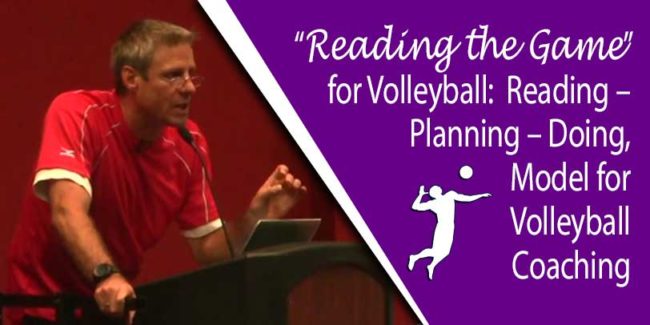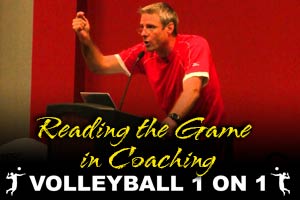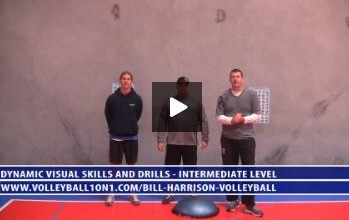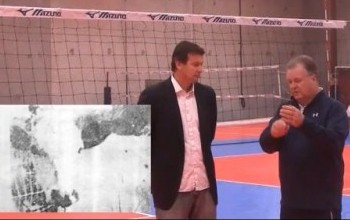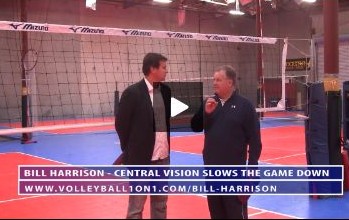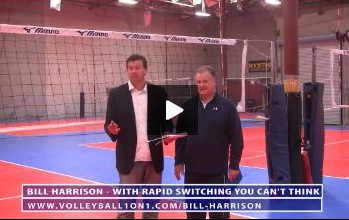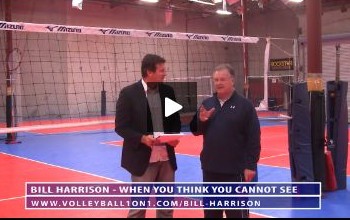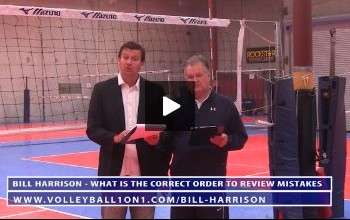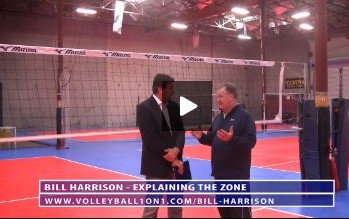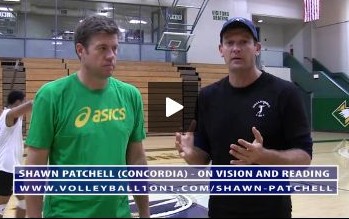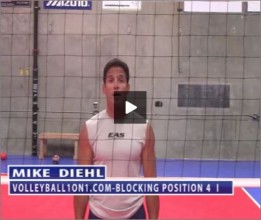In this category we share video, drills and articles as it relates to reading the game in volleyball coaching.
Section 1 – Volleyball1on1 OODA Loop Vision Coaching Blueprint Introduction In the last 7 years the biggest change in coaching the sport of volleyball has been “Reading the Game.” Most coaches teach it wrong in our opinion and miss where they can help their players best. We have spent the last seven years researching and…
There are roughly 640 muscles in the human body. Athletes spend an inordinate amount of time training and strengthening almost every single one of them. Yet there are six that are often forgotten: the Superior Oblique, Superior Rectus, Medial Rectus, Lateral Rectus, Inferior Rectus, and Inferior Oblique. Or, simply put: Your eyes. The aforementioned six…
Level 5 – Involves players “Observing,” “Orientating,” “Deciding,” and making an “Action” based upon information on one or more posters while watching and interacting with a separate moving object in constant motion while being actively distracted with the goal of moving the player out of their visual sensory mode. The purpose of level 5 exercises…
Level 4 – Involves players “Observing,” “Orientating,” “Deciding,” and making an “Action” based upon information on one or more posters while watching and interacting with a separate moving object in constant motion. The purpose of level 4 exercises are to help: Track a moving object, While scanning between 1, 2 or more posters, While performing…
Level 3 – Involves players “Observing,” “Orientating,” “Deciding,” and making an “Action” based upon information on one or more posters. Players are now ideally in constant motion. The purpose of level 3 exercises are to help: Improve “scanning for objects” while in motion. This is far more difficult than when stationary Improve players skill through…
Level 1 – Involves players “Observing” and “Orientating” information on one or more posters while being static, meaning not moving. The purpose of level 1 exercises are to help: Acclaimed athletes to the use of the OODA Loop posters Teach “scanning for objects” when training muscles in the eyes Teach players stage 1 – “Observation”…
We are excited to announce the launch of our Peak Performance OODA Loop Vision Training Posters. These 27″ x 39″ posters are ideal for helping athletes in all sports including volleyball improve their ability to process visual information and thereby speed up their ability to navigate the OODA Loop. Athletes who can more effectively move…
So this past week Reid Priddy (USA Volleyball Indoor Olympian Standout) did a Vlog (Video Blog) on a questions I asked him about vision. The question: “Do you have a vision routine for hitting?” His answer is here: This video is interesting on a number of fronts but most interesting as it relates to an…
This series of video is the result of over 3 years of personal research on “Reading the Game” and “How To Slow The Ball Down.” In the videos I review why Karch theories on Reading the Game are wrong in my opinion including why and how they can be dramatically improved! Many of these ideas…
A tale of two volleyball players, what defines a good player vs. a great player and how you can help your players become great? The sport of volleyball has undergone a wide variety of changes over the better part of the last decade: the scoring has changed, rules involving the net have changed, even the…
Flo Hyman used to be self-conscious about her height. Standing 6 feet tall before she was even a teenager, Hyman did everything in her power to shrink. And yet, more than half a century later, her name still towers in the world of volleyball. A three-time All-American and 1984 silver medalist, Hyman was named by…
This post contains 2 videos from Wes Schneider’s Standard Drill. How is a 6 on 6 drill where the goal is to have the offense side out at 70% while the defense scores at 50%. If for some reason the offense scores higher than 70% this becomes the standard that the other team needs to now side out at and obviously how you drill gets its name.
“Reading the game is the premier skill in volleyball” – Karch Kiraly. I DISAGREE! Great players and coaches go beyond “Reading the game” and have or coach the ability to slow the ball and game down after they receive information from their opponents. This FREE Video will show you how to do this successfully!
In this videos Chris Harger focuses on timing and setting the block as it relates to coaching youth volleyball blocking technique. Points discussed include: timing, where to set the block based upon the attack, tips for blocking the attacker and more.
In this videos Chris Harger focuses on vision and “Reading the game” as it relates to coaching youth volleyball blocking technique. Points discussed include: Visual sequence, ball – setter – ball – hitter, reading the setter, examples; overrunning the ball, dropping their hands, arching the back, set against the flow, reading the hitter, plus more.
In this powerful video the OODA Loop coaching cues are used to help the player discover most of her spiking problems have less to do with technique and more to do with “Reading” and Orientation of the set. The coaching of this is successfully done by Andor using guided discovery and great open probe questions where he is constantly checking in with the players emotionally so that they are not overwhelmed but rather take the feedback as a challenge and a opportunity to grow.
Volleyball players organize their movement patterns when performing a volleyball skill in advance. As the action or skill gets more complex so the reaction time increases as more time is required to organize the system for movement initiation. In this post we explore the idea and give examples.
This article contains a video example and verbal cues of how Andor Gyulai teaches volleyball spiking technique using the OODA Loop.
I would like to share an easy to use and easy understand example of how to OODA Loop your opponent using Hick’s law. This example was used on me initially quite effectively by my good friend Colin Pockock (Age 44) in South Africa who is a former beach volleyball Olympian who took a 9th at the 2004 Olympics. I think he is the best beach player in South Africa volleyball history.
After over 3 years of research through my own observations as a player and coach I realized the Reading – Planning – Doing system can be vastly improved, specifically how we as coaches teach players the process of how we as humans respond to stimuli (predominantly with our eyes), which is the basis of how all volleyball skills and sports are performed.
Did you know one of the biggest breakthroughs in the “science of coaching volleyball” today is called “Reading the Game”? Most of the ideas related to this were first introduced by Karch Kiraly (considered the greatest volleyball player in the sport) on his retirement and transition into coaching just a few years ago during a presentation at an AVCA Convention in San Antonio, Texas.
So for the last few years now perhaps the hottest topic in volleyball is the “Read the Game” concept. The idea was brought to light by a few of the best coaches in world including Karch Kiraly, Hugh McCutcheon, Paula Weishoff, Ron Larson and Tom Black. The idea is as follows, top players better see and read what is going to happen giving them a competitive edge as the play unfolds.
This is a series of 5 Intermediate Visual Drills and Skills we filmed with Bill and Ryan Harrison of SlowTheGameDown.com. Bill and Ryan are leaders and pioneer in the area of vision for sports. SlowTheGameDown, their company has been training elite hall of fame athletes for over 40 years. For Volleyball Bill has worked with Hall Famers Flo Hyman and AVP star and current USA coach Matt Fuerbringer.
Reading the game is described by many coaches and players including Karch Kiraly and Hugh McCutcheon as the premier skill in volleyball. This video is the first video in a series of videos we filmed with Dr. Bill Harrison on vision and reading the game using vision. This video builds on ideas and concepts brought forward by Karch Kiraly when he self analyzed his success as a player.
In this video Bill Harrison describes and teaches about central vision and how this skill if used correctly can significantly slow the game down. The problem is this skill has real physical limitations and it is important to understand these limitations when using the skill to improve athletic performance.
In this video Dr.Bill Harrison discusses how the rapid switching of your eyes stops thinking and forces only seeing. This is an extremely powerful concept that can be used by players to eliminate the focus on past errors that just happened and rather focus on the coming next play.
In this video Bill Harrison explains a critical idea for improving athletic performance. When You Think You Cannot See! This video will also help you be a better coach and also talk less, especially during games! 🙂
Until recently most coaches were flat out wrong as too why an error occurred in the kinetic chain of motor skill movement as it relates to sports. For most coaches the focus of the breakdown will generally be perceived as a breakdown in technique or a breakdown in mental concentration. What is interesting is that nothing could be further from the truth. Most mistakes in sports occur because of a breakdown in vision.
In this video Bill Harrison discusses important concepts as they relate to the zone, the peak the of athletic performance.
Shawn Patchell 5 In, 5 Out of System drill is a drill that works on defense – reading the game and on the offense calibrating their attack. This drill can be run with just 1 coach yet allow the coach to accomplish an incredible amount. This video combines 3 videos for easy viewing.
In this video Shawn discusses important points regarding reading the game and volleyball vision. Shawn has worked closely with some of the best in this area of volleyball on the national team and in this video it shows. This videos also brings home some of the important points on vision and blocking that were worked on in the 5 In, 5 Out of System Drill Earlier.
Mike talks about how to read queues from the setter and hitter when blocking. This includes: watch the setter’s body position, the hitter’s shoulder and more.
